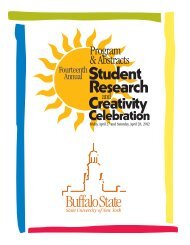POLITICS VERSUS SCIENCE: APPORTIONING ... - Buffalo State
POLITICS VERSUS SCIENCE: APPORTIONING ... - Buffalo State
POLITICS VERSUS SCIENCE: APPORTIONING ... - Buffalo State
Create successful ePaper yourself
Turn your PDF publications into a flip-book with our unique Google optimized e-Paper software.
centrally-located scientists in one research center disseminate this information to<br />
centrally-located scientists at other research centers. The attempt to identify the<br />
characteristics of key scientists soon intersected with research on opinion leaders.<br />
Working on a different front, scholars (for political scientists, famously Lazarsfeld) have<br />
attempted to profile and identify opinion leaders. Katz and Lazarsfeld (1955, 1) in their<br />
early studies of opinion leadership wrote that it is “casually exercised, sometimes<br />
unwitting and unbeknown…” Nevertheless, in the past 50 years scholars have made gains<br />
in understanding opinion leadership.<br />
There are two different types of leaders: innovator-leader and mediator-leader.<br />
Each has a different role to play in diffusing innovations in the organization (the former)<br />
and binding members together in a community (the latter). Leaders occupy linkage<br />
points between the different key areas of the network. Granovetter (1973) opened up a<br />
new line of inquiry when he suggested that weak ties played a critical bridging role in<br />
social networks. Members of cliques are not good sources of outside information<br />
because of the close nature of its participants: everyone knows what everyone else<br />
knows. Members, through weak ties to other cliques, bring in new information to their<br />
cliques. Key scientists communicate across cliques. In Weimann’s (1994: 203-204)<br />
review of the social constructivist approach to scientific communities, he concludes that:<br />
“The accumulating findings from numerous studies in various scientific areas indicated<br />
clearly the presence of a social circles and invisible colleges."<br />
We need only ask the same questions of the food policy regime that social<br />
network theorists routinely pose: “Does the Small-World Phenomenon arise at some<br />
point in the transition from order to disorder, and if so, what is responsible for it?” and<br />
30












